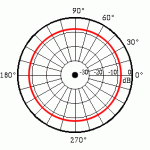I must say that I'm in the middle on this subject of directivity and how much it matters. Back when directivity wasn't even considered by most audiophiles, I made more a point of discussing its importance. But now that constant directivity has become more popular in hifi circles, I tend to find myself reminding the new converts not to throw the baby out with the bathwater.
That's why I often refer to speakers with uniform directivity rather than constant directivity. It is more important to me that the power response be uniform than it is for directivity to be constant. They are similar, but not exactly the same.
To illustrate what I mean, consider two loudspeakers, one designed for uniform directivity and another designed solely for flat on-axis response.
The "traditional" loudspeaker designed for flat on-axis response has a woofer that is omnidirectional at LF and crossed-over where convenient. Not that it is a design criteria, but at this point, woofer beamwidth has narrowed, probably in the vicinity of 90°. The tweeter is omnidirectional at crossover and its beamwidth doesn't narrow to 90° until the top octave. Measured response is flat on-axis.
The speaker designed for uniform directivity is crossed-order where woofer and tweeter directivity match. So instead of beamwidth narrowing through the woofer band, then widening as the tweeter is crossed-in, the tweeter directivity matches the directivity of the woofer and remains relatively constant at that point. Alternatively, some designs have the tweeter beamwidth continue to narrow.
Provided there is no abrupt beamwidth jump, I would consider both approaches to be "uniform directivity" designs.
Why does this matter?
Because people listening at at off-axis angles hear smooth response from the speaker that provides uniform directivity, but they don't from the other design. Also, the reverberent field is more natural when the uniform directivity speaker is playing, and that's important because that's the sound that surrounds you. It's as simple as that.
My experience with constant directivity designs started by making Klipschorn-style cornerhorns with constant directivity horns. I learned early on that they did something special where imaging was concerned. The walls confined the midrange and midbass down to the Schroeder frequency, so the sound was uniform throughout the room. Directivity is constant through the entire audio band in a design like this.
There is no way to be outside the pattern in a design like this. It is unique in that regard, and has always been my favorite design approach. But rooms with the right layout to support constant directivity cornerhorns are rare.
Another option presented itself, which is the matched-directivity approach. Physically, it is the same thing as the large Altecs and the JBL 4430. Those were my inspiration for this second design approach. They don't provide constant directivity, because the radiation pattern is omnidirectonal at low frequencies and beamwidth narrows as frequency goes up. But the directivity is at least uniform, and that means off-axis response is still flat. It may have a downward slope, but it is relatively smooth.
Speakers with uniform directivity sound more natural because the reverberent field has spectral balance.
One problem presents itself, and that is horns that provide constant directivity sometimes don't sound all that good. The best example is early CD horns with sharp edges inside. The discontinuities created by the sharp edges cause internal reflections and response anomalies. So I switched back to radial horns early on. These provide nearly constant horizontal beamwidth and gently collapsing vertical beamwidth. That is a very good characteristic for home hifi, in my opinion.
Prosound horns have a different set of priorities where constant directivity if concerned. Prosound horns not only need high-efficiency and constant beamwidth, but they must also be arrayable. This means they have to concern themselves with things like astigmatism, pattern flip and waistbanding. As an example of why those things are important, consider an installation where horns are splayed. In this arrangement, the primary lobe of one horn gets interference from the secondary lobe of the adjacent horn. So in this case, the characteristics of the sound radiated outside the pattern is as important as the sound radiated within the pattern.
A prosound horn design will allow some response ripple and other anomalous behavior within the pattern for "good behavior" outside the pattern. This makes sense, because horns in a prosound environment will be arrayed, so it doesn't make sense to optimize the horn for single use.
But there are a different set of priorities for a horn/waveguide designed for studio monitors or for home hifi use.
For home hifi, we want the response in the pattern to be as smooth and clean as possible, and ideally we want the beamwidth to be as constant as possible too. But where a trade-off must be struck, it doesn't make sense to optimize the response at the extreme edge of the pattern or outside, like we might choose to do in a prosound horn. The home hifi horn will not be arrayed. So the best approach is to make the radiation pattern uniform and to optimize response within the pattern.
This brings me back to what I said in the first paragraph about some people throwing the baby out with the bathwater. I'm all for uniform directivity, and found myself regularly arguing its virtues over the years. But it seems like lately, I see guys posting polars and sonograms, looking for a holy grail in its virtues. Some have gone way too far with that, in my opinion, and are using prosound techniques to build home hifi speakers. Their polars look wonderful, but their response curves and distortion performance is only so-so.
Compare the two curves on the chart below and you'll see what I mean. These are two waveguides that are approximately the same size, designed to be used over the same passband. One is optimized to provide smooth response, the other to provide constant beamwidth. The one with smoother response has about 2dB ripple, but directivity narrows slightly below 2kHz, before pattern control is completely lost around 1kHz. It is also 3dB louder with the same input signal, so drive voltage requirements are reduced, lowering distortion. The other waveguide has about 5dB ripple, but is able to maintain beamwidth down to its lower cutoff around 1kHz.
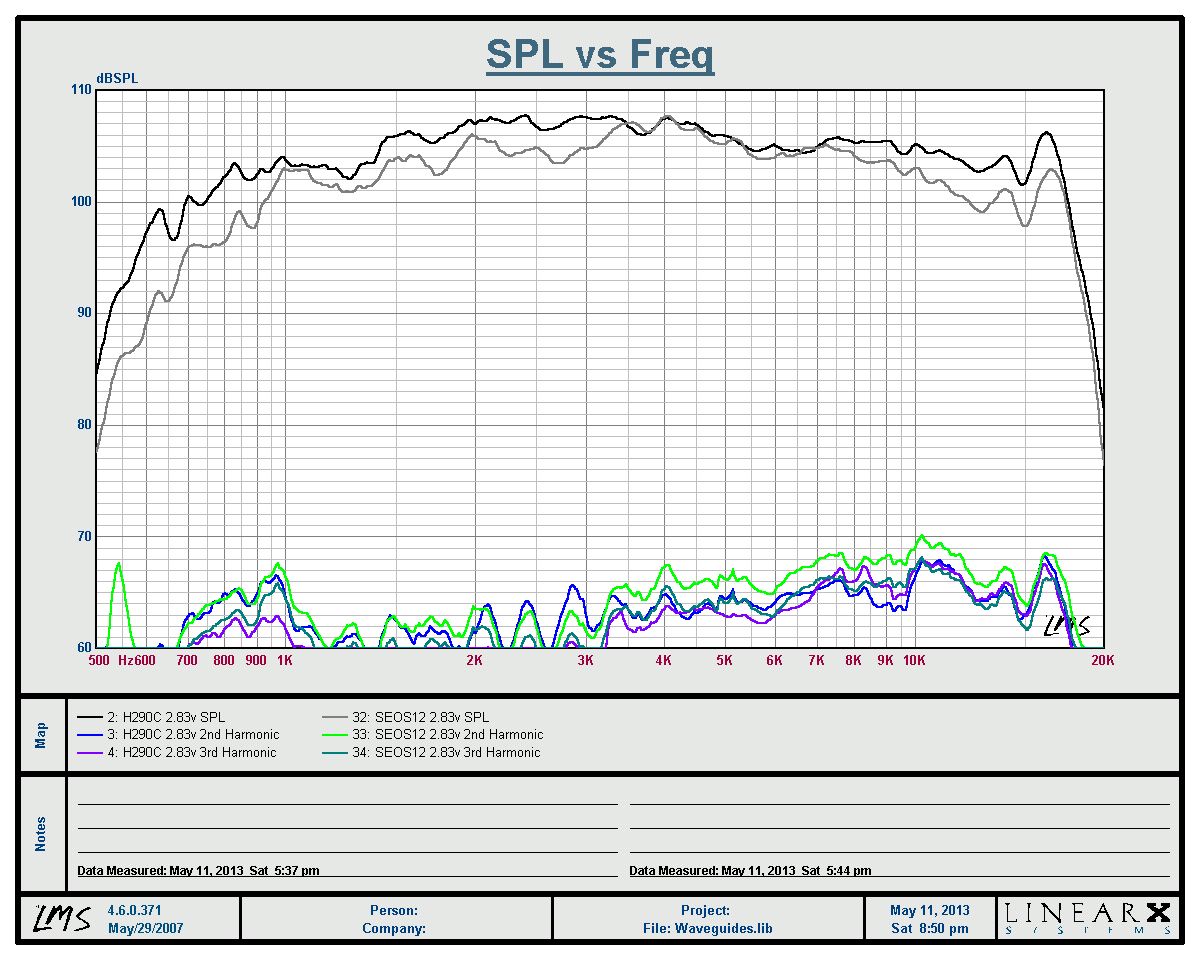
I've measured several different horns over the years, from radials to tractrix, and a lot of them are captured in the link below. Look through the list and you can see measurements of various types of horns and waveguides:
Remember the examples above, the traditional loudspeaker with the 90°-to-omni shift compared with the speaker having uniform directivity? In this case, when we compare response at 45° off axis, we see the traditional speaker has a 6dB dip at the crossover point, because the 90° beamwidth is defined by its -6dB point. The speaker with uniform directivity has no dip, its off-axis curve is a straight diagonal line.
But what about a speaker with a smidge of waistbanding? This is something to avoid in the prosound world, because a horn creates a secondary lobe in the waistbanding region, and this secondary lobe interferes with the primary lobe of another horn in an array. Not so in a home hifi setup, because there is no other other horn to interfere with. So what other consequence do we see from wasitbanding?
Waistbanding is a "pinch" of the pattern at low frequencies. An example is a horn/waveguide that provides constant 90° beamwidth from say 2kHz up, but that narrows to 70° below that, before ultimately opening wide up approaching omnidirectional radiation at low frequencies below 1kHz where pattern control is completely lost. A sonogram will show this "pinch" in the 1kHz to 2kHz region.
What does it mean in a home hifi environment? Practically nothing, it's inaudible. What is really happening is the sound at 45° is reduced slightly between 1kHz and 2kHz, and by slightly, I mean about 2dB. It is minor, nothing like the 6dB dip off-axis of a traditional loudspeaker designed solely for on-axis response.
Does that mean waistbanding is completely insignificant? Of course not. Would we want to design to reduce it? Certainly, provided there are no other trade-offs. But there are trade-offs, there are always trade-offs. The most common mechanism to counter waistbanding is a secondary flare, and this increases horn size, which increasese center-to-center distance, which in turn brings the vertical nulls closer, limiting the size of the forward lobe. Or worse, if the mouth size must remain constant, then adding asecondary flare requires shortening the main body of the horn, modifying the flare profile and possibly truncating it. This introduces extra ripple. That may be worthwhile in a prosound horn, but it probably isn't in a waveguide designed to be used in a studio monitor or home hifi speaker.
Which leads me back to the radial horns. I personally would rather have a radial horn that provided constant directivity in the horizontal, gently collapsing directivity in the vertical and smooth respponse in the pattern than I would a so-called "waveguide" that had peaky response. I've seen some out there that have 5dB ripple, and that's about twice what I would be willing to live with.
A good hifi horn offers response flat within a 2dB window, and a good studio monitor waveguide is able to do this too. The waveguide usually cannot be used to as low frequency as a similarly sized (exponential) radial horn, because the waveguide's acoustic loading isn't as good at low frequencies. It has this in commmon with a tractrix horn, which also loads relatively poorly down low. But it need not increase response ripple like prosound horns do, otherwise it has thrown the baby out with the bathwater.
That's why I often refer to speakers with uniform directivity rather than constant directivity. It is more important to me that the power response be uniform than it is for directivity to be constant. They are similar, but not exactly the same.
To illustrate what I mean, consider two loudspeakers, one designed for uniform directivity and another designed solely for flat on-axis response.
The "traditional" loudspeaker designed for flat on-axis response has a woofer that is omnidirectional at LF and crossed-over where convenient. Not that it is a design criteria, but at this point, woofer beamwidth has narrowed, probably in the vicinity of 90°. The tweeter is omnidirectional at crossover and its beamwidth doesn't narrow to 90° until the top octave. Measured response is flat on-axis.
The speaker designed for uniform directivity is crossed-order where woofer and tweeter directivity match. So instead of beamwidth narrowing through the woofer band, then widening as the tweeter is crossed-in, the tweeter directivity matches the directivity of the woofer and remains relatively constant at that point. Alternatively, some designs have the tweeter beamwidth continue to narrow.
Provided there is no abrupt beamwidth jump, I would consider both approaches to be "uniform directivity" designs.
Why does this matter?
Because people listening at at off-axis angles hear smooth response from the speaker that provides uniform directivity, but they don't from the other design. Also, the reverberent field is more natural when the uniform directivity speaker is playing, and that's important because that's the sound that surrounds you. It's as simple as that.
My experience with constant directivity designs started by making Klipschorn-style cornerhorns with constant directivity horns. I learned early on that they did something special where imaging was concerned. The walls confined the midrange and midbass down to the Schroeder frequency, so the sound was uniform throughout the room. Directivity is constant through the entire audio band in a design like this.
There is no way to be outside the pattern in a design like this. It is unique in that regard, and has always been my favorite design approach. But rooms with the right layout to support constant directivity cornerhorns are rare.
Another option presented itself, which is the matched-directivity approach. Physically, it is the same thing as the large Altecs and the JBL 4430. Those were my inspiration for this second design approach. They don't provide constant directivity, because the radiation pattern is omnidirectonal at low frequencies and beamwidth narrows as frequency goes up. But the directivity is at least uniform, and that means off-axis response is still flat. It may have a downward slope, but it is relatively smooth.
Speakers with uniform directivity sound more natural because the reverberent field has spectral balance.
One problem presents itself, and that is horns that provide constant directivity sometimes don't sound all that good. The best example is early CD horns with sharp edges inside. The discontinuities created by the sharp edges cause internal reflections and response anomalies. So I switched back to radial horns early on. These provide nearly constant horizontal beamwidth and gently collapsing vertical beamwidth. That is a very good characteristic for home hifi, in my opinion.
Prosound horns have a different set of priorities where constant directivity if concerned. Prosound horns not only need high-efficiency and constant beamwidth, but they must also be arrayable. This means they have to concern themselves with things like astigmatism, pattern flip and waistbanding. As an example of why those things are important, consider an installation where horns are splayed. In this arrangement, the primary lobe of one horn gets interference from the secondary lobe of the adjacent horn. So in this case, the characteristics of the sound radiated outside the pattern is as important as the sound radiated within the pattern.
A prosound horn design will allow some response ripple and other anomalous behavior within the pattern for "good behavior" outside the pattern. This makes sense, because horns in a prosound environment will be arrayed, so it doesn't make sense to optimize the horn for single use.
But there are a different set of priorities for a horn/waveguide designed for studio monitors or for home hifi use.
For home hifi, we want the response in the pattern to be as smooth and clean as possible, and ideally we want the beamwidth to be as constant as possible too. But where a trade-off must be struck, it doesn't make sense to optimize the response at the extreme edge of the pattern or outside, like we might choose to do in a prosound horn. The home hifi horn will not be arrayed. So the best approach is to make the radiation pattern uniform and to optimize response within the pattern.
This brings me back to what I said in the first paragraph about some people throwing the baby out with the bathwater. I'm all for uniform directivity, and found myself regularly arguing its virtues over the years. But it seems like lately, I see guys posting polars and sonograms, looking for a holy grail in its virtues. Some have gone way too far with that, in my opinion, and are using prosound techniques to build home hifi speakers. Their polars look wonderful, but their response curves and distortion performance is only so-so.
Compare the two curves on the chart below and you'll see what I mean. These are two waveguides that are approximately the same size, designed to be used over the same passband. One is optimized to provide smooth response, the other to provide constant beamwidth. The one with smoother response has about 2dB ripple, but directivity narrows slightly below 2kHz, before pattern control is completely lost around 1kHz. It is also 3dB louder with the same input signal, so drive voltage requirements are reduced, lowering distortion. The other waveguide has about 5dB ripple, but is able to maintain beamwidth down to its lower cutoff around 1kHz.

I've measured several different horns over the years, from radials to tractrix, and a lot of them are captured in the link below. Look through the list and you can see measurements of various types of horns and waveguides:
Remember the examples above, the traditional loudspeaker with the 90°-to-omni shift compared with the speaker having uniform directivity? In this case, when we compare response at 45° off axis, we see the traditional speaker has a 6dB dip at the crossover point, because the 90° beamwidth is defined by its -6dB point. The speaker with uniform directivity has no dip, its off-axis curve is a straight diagonal line.
But what about a speaker with a smidge of waistbanding? This is something to avoid in the prosound world, because a horn creates a secondary lobe in the waistbanding region, and this secondary lobe interferes with the primary lobe of another horn in an array. Not so in a home hifi setup, because there is no other other horn to interfere with. So what other consequence do we see from wasitbanding?
Waistbanding is a "pinch" of the pattern at low frequencies. An example is a horn/waveguide that provides constant 90° beamwidth from say 2kHz up, but that narrows to 70° below that, before ultimately opening wide up approaching omnidirectional radiation at low frequencies below 1kHz where pattern control is completely lost. A sonogram will show this "pinch" in the 1kHz to 2kHz region.
What does it mean in a home hifi environment? Practically nothing, it's inaudible. What is really happening is the sound at 45° is reduced slightly between 1kHz and 2kHz, and by slightly, I mean about 2dB. It is minor, nothing like the 6dB dip off-axis of a traditional loudspeaker designed solely for on-axis response.
Does that mean waistbanding is completely insignificant? Of course not. Would we want to design to reduce it? Certainly, provided there are no other trade-offs. But there are trade-offs, there are always trade-offs. The most common mechanism to counter waistbanding is a secondary flare, and this increases horn size, which increasese center-to-center distance, which in turn brings the vertical nulls closer, limiting the size of the forward lobe. Or worse, if the mouth size must remain constant, then adding asecondary flare requires shortening the main body of the horn, modifying the flare profile and possibly truncating it. This introduces extra ripple. That may be worthwhile in a prosound horn, but it probably isn't in a waveguide designed to be used in a studio monitor or home hifi speaker.
Which leads me back to the radial horns. I personally would rather have a radial horn that provided constant directivity in the horizontal, gently collapsing directivity in the vertical and smooth respponse in the pattern than I would a so-called "waveguide" that had peaky response. I've seen some out there that have 5dB ripple, and that's about twice what I would be willing to live with.
A good hifi horn offers response flat within a 2dB window, and a good studio monitor waveguide is able to do this too. The waveguide usually cannot be used to as low frequency as a similarly sized (exponential) radial horn, because the waveguide's acoustic loading isn't as good at low frequencies. It has this in commmon with a tractrix horn, which also loads relatively poorly down low. But it need not increase response ripple like prosound horns do, otherwise it has thrown the baby out with the bathwater.
To offer a little more information, consider the following sonograms:
First, the ideal directivity pattern would be constant through the entire audio band. A constant directivity cornerhorn comes close to this, because the walls confine the beam down low, and the midhorn and tweeter waveguides set the pattern up high. So basically, the whole room is the "sweet spot."
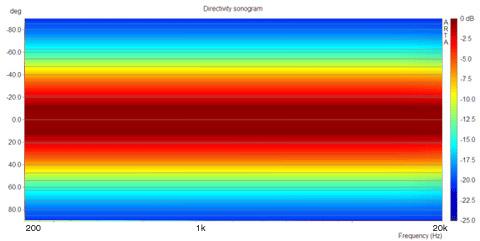
Of course, that's an idealized sonogram, and in the real world, room modes will break up that nice pretty picture and make pockets of hot and dead spots throughout the room below the Schroeder frequency, around 200Hz or so. That's what flanking subs and distributed multisubs seek to mitigate.
But that's a whole different subject. For now, back to tweeter waveguides.
Now the opposite end of the scale, a sonogram that is audibly deficient. This shows approximately 90° beamwidth up to 1.6kHz, then widening to over 120° to 6kHz, then narrowing to 40° above that.
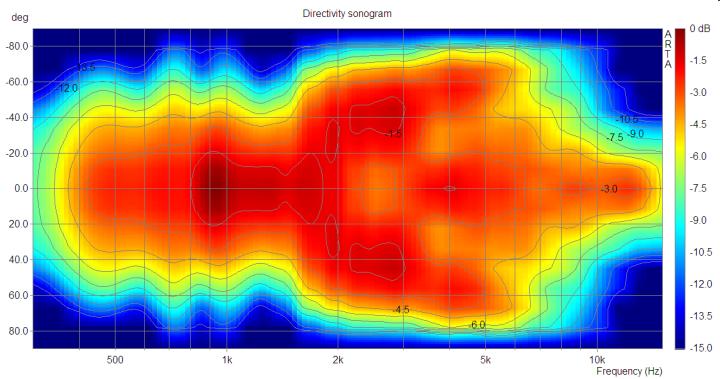
The problem is the response off-axis. A listener that's sitting on-axis gets a different sonic presentation than a person sitting at 30° off-axis, and another person at 45° gets another completely different presentation. There is no spectral balance for listeners off-axis more than about 20°.
Look at the legend to the right. See the colors, and how they relate to SPL. At 45°, the sound is -6dB compared to the on-axis level below 1.6kHz. It rises nearly to the on-axis SPL, maybe -2dB in the 1.6kHz to 6kHz region, and then falls rapidly above that, being approximately -12dB at 12kHz.
Said another way, imagine the response curve for a listener sitting 40° off-axis. For that person, the response blooms about 4dB from 1.6kHz to 6kHz, and then it falls rapidly down to about -6dB by 12kHz.
This is non-uniform directivity, and it is something I would personally not want.
But now let's look at some popular horn/waveguides that provide good directivity.
This is a horn/waveguide that provide near-ideal beamwidth. As you can see, the sonogram is reasonably flat. It stays locked-on at 45° beamwidth across the band.
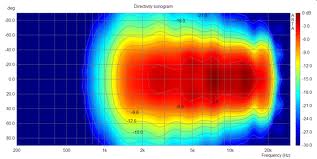
But what if there are design features that cause this horn to have 5dB ripple on-axis, as well as off-axis? In a way, it doesn't matter that the polars are nice and pretty, because there is a lot of ripple no matter where you sit.
Here are some sonograms of horn/waveguides that show some waistbanding, but that are still very good.
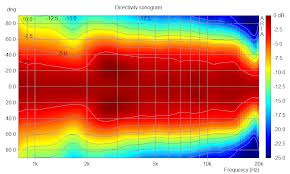
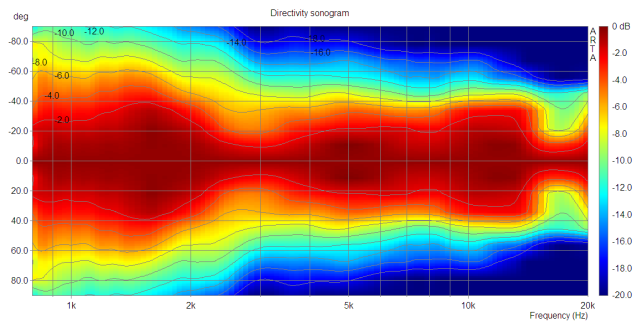
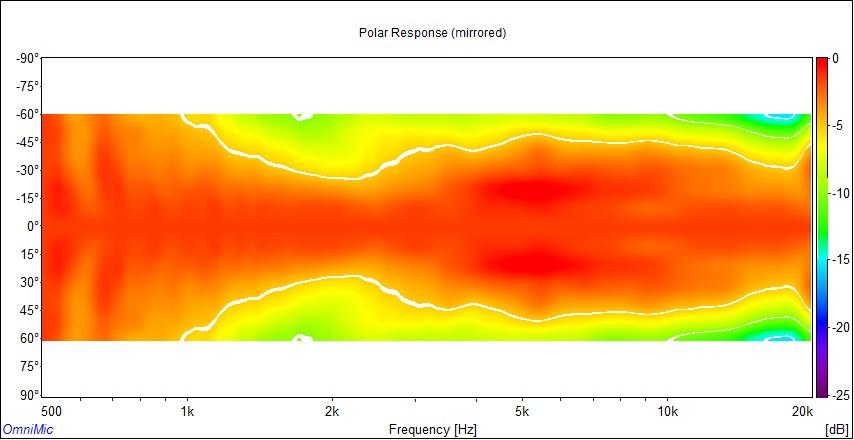
In each case, you will notice the beamwidth is 45° from midband up. But down low, there is a little bit of a pinch in the beamwidth.
Examine each chart closely, and look at the legend. Remember that the beamwidth is defined as the angle where response is -6dB down from the on-axis level. So since each of these waveguides is a 90° device, and since each shows some waistbanding down low, look and see what the SPL is in the "pinched" region. What you will notice is that instead of being -6dB, it is a little more, like -8dB from the on-axis level. What you are actually seeing in these charts are devices that have about 2dB less output at 45° off-axis in the waistbanding region.
In some cases, this may be in the crossover overlap region, where the woofer and tweeter directivities blend. If so, the waistbanding may be masked. But even if it isn't, or if it is only partially blended, we're still talking about a relatively minor anomaly. It isn't as though waistbanding is entirely trivial, but it is more important in prosound applications, where arrayability is important. For high-fidelity monitoring applications, I would prefer the waveguide have smooth response through the pattern as its primary design goal.
In the end, the matched-directivity design will look something like this, with woofer and tweeter blended:
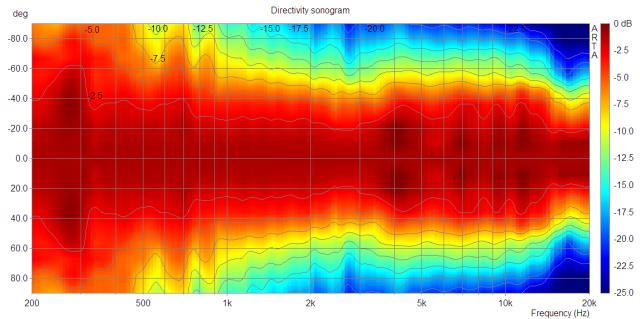
First, the ideal directivity pattern would be constant through the entire audio band. A constant directivity cornerhorn comes close to this, because the walls confine the beam down low, and the midhorn and tweeter waveguides set the pattern up high. So basically, the whole room is the "sweet spot."

Of course, that's an idealized sonogram, and in the real world, room modes will break up that nice pretty picture and make pockets of hot and dead spots throughout the room below the Schroeder frequency, around 200Hz or so. That's what flanking subs and distributed multisubs seek to mitigate.
But that's a whole different subject. For now, back to tweeter waveguides.
Now the opposite end of the scale, a sonogram that is audibly deficient. This shows approximately 90° beamwidth up to 1.6kHz, then widening to over 120° to 6kHz, then narrowing to 40° above that.

The problem is the response off-axis. A listener that's sitting on-axis gets a different sonic presentation than a person sitting at 30° off-axis, and another person at 45° gets another completely different presentation. There is no spectral balance for listeners off-axis more than about 20°.
Look at the legend to the right. See the colors, and how they relate to SPL. At 45°, the sound is -6dB compared to the on-axis level below 1.6kHz. It rises nearly to the on-axis SPL, maybe -2dB in the 1.6kHz to 6kHz region, and then falls rapidly above that, being approximately -12dB at 12kHz.
Said another way, imagine the response curve for a listener sitting 40° off-axis. For that person, the response blooms about 4dB from 1.6kHz to 6kHz, and then it falls rapidly down to about -6dB by 12kHz.
This is non-uniform directivity, and it is something I would personally not want.
But now let's look at some popular horn/waveguides that provide good directivity.
This is a horn/waveguide that provide near-ideal beamwidth. As you can see, the sonogram is reasonably flat. It stays locked-on at 45° beamwidth across the band.

But what if there are design features that cause this horn to have 5dB ripple on-axis, as well as off-axis? In a way, it doesn't matter that the polars are nice and pretty, because there is a lot of ripple no matter where you sit.
Here are some sonograms of horn/waveguides that show some waistbanding, but that are still very good.



In each case, you will notice the beamwidth is 45° from midband up. But down low, there is a little bit of a pinch in the beamwidth.
Examine each chart closely, and look at the legend. Remember that the beamwidth is defined as the angle where response is -6dB down from the on-axis level. So since each of these waveguides is a 90° device, and since each shows some waistbanding down low, look and see what the SPL is in the "pinched" region. What you will notice is that instead of being -6dB, it is a little more, like -8dB from the on-axis level. What you are actually seeing in these charts are devices that have about 2dB less output at 45° off-axis in the waistbanding region.
In some cases, this may be in the crossover overlap region, where the woofer and tweeter directivities blend. If so, the waistbanding may be masked. But even if it isn't, or if it is only partially blended, we're still talking about a relatively minor anomaly. It isn't as though waistbanding is entirely trivial, but it is more important in prosound applications, where arrayability is important. For high-fidelity monitoring applications, I would prefer the waveguide have smooth response through the pattern as its primary design goal.
In the end, the matched-directivity design will look something like this, with woofer and tweeter blended:

It's not a crusade against anyone. This is a technical discussion. One that I would appreciate nobody derail into name calling, or turning it into something personal.
I can't stand it when an opinion or technical argument is made, and then the response is an ad-hominem attack. That's nothing but a distraction, pure subterfuge. I've seen it before - Seems to be used by some as a fairly clever way to sequester a discussion. Demonize your opponent so that only one side is heard.
And it hasn't been the designers on either side that have done that, if you'll notice. The "crusade" came from somewhere else. It was an emotional ploy, and some innocent parties have been really harmed as a result.
So can we agree to drop that right here and now? I left the other website when they started getting nasty, and it would be a shame to have this thread go the same way. Let's leave the personal stuff out of it, OK?
The truth is there has been a long-running technical email chain just like this going on behind the scenes, and it is with me and the guys that designed SEOS. The designers of that device are people I would consider friends.
The two design philosophies are really the same - Pi H290C and SEOS12 - with the subtle difference that each has been optimized slightly differently.
When you talk purely about the technology, you find the two are more alike than different, one sharing design approaches from the other. They are almost brothers, each having similar traits along with a few differences.
Bearing all that in mind, what do you think of the idea that I've proposed? Do you think a home hifi waveguide should be optimized for smoothness or for pattern control?
I can't stand it when an opinion or technical argument is made, and then the response is an ad-hominem attack. That's nothing but a distraction, pure subterfuge. I've seen it before - Seems to be used by some as a fairly clever way to sequester a discussion. Demonize your opponent so that only one side is heard.
And it hasn't been the designers on either side that have done that, if you'll notice. The "crusade" came from somewhere else. It was an emotional ploy, and some innocent parties have been really harmed as a result.
So can we agree to drop that right here and now? I left the other website when they started getting nasty, and it would be a shame to have this thread go the same way. Let's leave the personal stuff out of it, OK?
The truth is there has been a long-running technical email chain just like this going on behind the scenes, and it is with me and the guys that designed SEOS. The designers of that device are people I would consider friends.
The two design philosophies are really the same - Pi H290C and SEOS12 - with the subtle difference that each has been optimized slightly differently.
When you talk purely about the technology, you find the two are more alike than different, one sharing design approaches from the other. They are almost brothers, each having similar traits along with a few differences.
Bearing all that in mind, what do you think of the idea that I've proposed? Do you think a home hifi waveguide should be optimized for smoothness or for pattern control?
I don't have the technical background to contribute a whole lot to this discussion, but nonetheless it seems to me that there is some merit to the notion that pattern control is a parameter worth optimizing if one should choose to - particularly if one intends the targeted speaker design to be set up with a severe toe-in such that multiple listeners may be quite far off the forward axis of at least one of the speakers much of the time.
Another possible benefit might be that any FR deviations deemed important enough to address via crossover work will be corrected both on- and off-axis simultaneously.
Potaytoes potahtoes, nothing in audio is without compromises and (sometimes difficult) choices. You've made some excellent points and expressed your thoughts very well, as usual. I'll enjoy following along if any productive discussion comes of this.
Another possible benefit might be that any FR deviations deemed important enough to address via crossover work will be corrected both on- and off-axis simultaneously.
Potaytoes potahtoes, nothing in audio is without compromises and (sometimes difficult) choices. You've made some excellent points and expressed your thoughts very well, as usual. I'll enjoy following along if any productive discussion comes of this.
Oh, absolutely. I agree, 100%. Do not mistake my meaning and think I am saying directivity is unimportant. My whole design approach for years - decades - has been precisely the opposite, that it is very important.
In prosound, in fact, it is probably the most important thing. This is largely because prosound horns are always arrayed - they're never used individually, but in groups. So the behavior in groups takes priority, and optimizations are necessarily different for them.
What I am trying to say, actually, is that I would not sacrifice response within the pattern for a waveguide designed for a studio monitor or home hifi loudspeaker. It is still important that directivity be very uniform though, in my opinion.
Be sure to look closely at those charts. If you study them closely, I think you'll see what I mean.
In prosound, in fact, it is probably the most important thing. This is largely because prosound horns are always arrayed - they're never used individually, but in groups. So the behavior in groups takes priority, and optimizations are necessarily different for them.
What I am trying to say, actually, is that I would not sacrifice response within the pattern for a waveguide designed for a studio monitor or home hifi loudspeaker. It is still important that directivity be very uniform though, in my opinion.
Be sure to look closely at those charts. If you study them closely, I think you'll see what I mean.
I'd like to think that uniform directivity/power response is a goal that all speaker systems should seek to accomplish. A smooth FR equally important with low HD of all orders and dynamically capable. Getting all those stars to align is another matter entirely! Lol. None of my own attempts/designs have met my own goals listed above. I simply don't have the time or finances at my disposal to work any harder at it.
Without having measurements to back it up, I will say the the JBL M-2 monitor, from a subjective listening experience, comes closer than any speaker I've heard to date.
Without having measurements to back it up, I will say the the JBL M-2 monitor, from a subjective listening experience, comes closer than any speaker I've heard to date.
It's not a crusade against anyone. This is a technical discussion. One that I would appreciate nobody derail into name calling, or turning it into something personal.
Let's review some comments from post #1.
This brings me back to what I said in the first paragraph about some people throwing the baby out with the bathwater. I'm all for uniform directivity, and found myself regularly arguing its virtues over the years. But it seems like lately, I see guys posting polars and sonograms, looking for a holy grail in its virtues. Some have gone way too far with that, in my opinion, and are using prosound techniques to build home hifi speakers. Their polars look wonderful, but their response curves and distortion performance is only so-so.
Shortly after this comment you posted a pic clearly showing the response of a SEOS waveguide (but no proof of the so-so response curves and distortion performance IN A COMPLETE SYSTEM with a LF driver and crossover), and then a bit later you follow up with this evaluation of the graph:
Which leads me back to the radial horns. I personally would rather have a radial horn that provided constant directivity in the horizontal, gently collapsing directivity in the vertical and smooth respponse in the pattern than I would a so-called "waveguide" that had peaky response. I've seen some out there that have 5dB ripple, and that's about twice what I would be willing to live with.
A good hifi horn offers response flat within a 2dB window, and a good studio monitor waveguide is able to do this too... But it need not increase response ripple like prosound horns do, otherwise it has thrown the baby out with the bathwater.
That sounds like an attack, not a technical discussion. But if you want to discuss it technically you have to admit that the raw response of a waveguide (without showing the LF driver or the effects of the crossover) isn't showing the whole picture. Here's the responses of a few different SEOS products, unfortunately a quick product search didn't show any off axis responses of the particular SEOS that you measured. Starting with the ones that do have off axis response shown:
Fusion 15
An externally hosted image should be here but it was not working when we last tested it.
Alpha 8
An externally hosted image should be here but it was not working when we last tested it.
They are not perfect but I don't see any babies in that bathwater. The following don't show off axis but I'm sure the off axis measurements are no worse than those shown above.
Fusion 8
An externally hosted image should be here but it was not working when we last tested it.
Fusion 12
An externally hosted image should be here but it was not working when we last tested it.
Alpha 12
An externally hosted image should be here but it was not working when we last tested it.
As far as I can see the raw response is just one data point, not a baby/bathwater situation (unless the waveguide is very bad, which these clearly are not).
I can't stand it when an opinion or technical argument is made, and then the response is an ad-hominem attack. That's nothing but a distraction, pure subterfuge. I've seen it before - Seems to be used by some as a fairly clever way to sequester a discussion. Demonize your opponent so that only one side is heard.
And it hasn't been the designers on either side that have done that, if you'll notice. The "crusade" came from somewhere else. It was an emotional ploy, and some innocent parties have been really harmed as a result.
So can we agree to drop that right here and now? I left the other website when they started getting nasty, and it would be a shame to have this thread go the same way. Let's leave the personal stuff out of it, OK?
As soon as I saw the name "SEOS" on the graph and saw your conclusions, I thought exactly the same thing as Pallas. Given your history with the SEOS people don't you think you should have at least cropped the "SEOS" name off the graph if you really wanted a technical discussion? Or maybe chosen another waveguide entirely to critique? You've measured dozens of waveguides, why pick this one?
You say "when they started getting nasty". Maybe I need to reread the discussion again, but I think both sides got pretty nasty when you tried to shame and emotionally blackmail a non profit into donating proceeds to someone that had nothing to do with the currently available products. Is that the innocent party that has been really harmed? IIRC, that innocent party wanted nothing to do with diysoundgroup or it's new and unique products.
Please believe I'm not a diysoundgroup fanboy even though I really wanted to be. I've got a laundry list of complaints with them so I have no horse in this race.
The truth is there has been a long-running technical email chain just like this going on behind the scenes, and it is with me and the guys that designed SEOS. The designers of that device are people I would consider friends.
The two design philosophies are really the same - Pi H290C and SEOS12 - with the subtle difference that each has been optimized slightly differently.
When you talk purely about the technology, you find the two are more alike than different, one sharing design approaches from the other. They are almost brothers, each having similar traits along with a few differences.
Bearing all that in mind, what do you think of the idea that I've proposed? Do you think a home hifi waveguide should be optimized for smoothness or for pattern control?
If you really want a technical discussion I think you should start again with a different waveguide to critique, or at least crop the SEOS name out of picture for at least an appearance of objectivity. But until then, my opinion is that the SEOS waveguides can be optimized for very good smoothness AND pattern control, from what I've seen. I don't own any of their products but I've seen a whole bunch of on and off axis measurements and good designers seem to be able to produce good designs with them.
EDIT - I guess the pics don't show up but they are all available on their product pages. I'm sure everyone knows where to look. (Or just right click and open in a new tab or window and they show up.)
Last edited:
What I am trying to say, actually, is that I would not sacrifice response within the pattern for a waveguide designed for a studio monitor or home hifi loudspeaker. It is still important that directivity be very uniform though, in my opinion.
Hi Wayne,
Interesting comment. Putting all emphasis on directivity sometimes has it's price.
http://www.bodziosoftware.com.au/Frequency_Time_Evaluation.pdf
Best Regards,
Bohdan
In a typical room, or especially a lively room, poor off axis linearity can make an otherwise well designed speaker, sound poor...especially outside the "sweet spot".1. On axis linearity
2. Distortion performance
3. Phase integration
4. Off axis Linearity
That's where I see uniform directivity falling on the order of importance. You can obviously have a great sounding speaker without it...
In a typical room, or especially a lively room, poor off axis linearity can make an otherwise well designed speaker, sound poor...especially outside the "sweet spot".
This is a simple generalization and doesn't apply to every situation, or speaker. A few db more energy greater then 45 degrees off axis between 2-4 khz does not magically take over the entire room when you are listening to the on axis sound of the speakers... This idea is just getting ridiculous

Correct me if im wrong, but you can eq a bumpy fr, you cant eq directivity.
In that case my vote would be for directivity to be the priorty.
They aren't mutually exclusive. If you change the on axis response you also change the off axis response.
Neither on or off axis needs to be flat in the raw response but after the crossover (including any contouring filters) is applied and integrated with the LF driver, both the on axis and off axis should be reasonably flat (meaning reasonably free of ripple - the off axis may or may not smoothly decrease in amplitude as frequency rises).
Last edited:
Try it, you'll see. Or just listen to a pair of Wilson speakers.This is a simple generalization and doesn't apply to every situation, or speaker. A few db more energy greater then 45 degrees off axis between 2-4 khz does not magically take over the entire room when you are listening to the on axis sound of the speakers... This idea is just getting ridiculous
Good points, all good points. I agree with most of what I've read here so far.
In particular, I agree that equalization of a constant directivity source provides response tailoring of all axes within the beam simultaneously.
But I would also counter that the idealized constant directivity is never really realized. We only have degrees of closeness to this ideal, which is why I often refer to loudspeakers with collapsing DI at the low end and relatively constant directivity up high as "uniform directivity" loudspeakers. They do not provide constant directivity, but what they do provide is fairly smooth and uniform. I think it's a good approach.
I would also suggest that large, abrupt directivity swings are to be avoided because they represent off-axis response abberrations. I think I gave the example of a woofer with 90° beamwidth crossed-over to a tweeter with omni radiation (180° because of the baffle). That creates a 6dB shift in the response at large off-axis angles, which is obvious and audible. But naturally smaller directivity shifts are less audible.
Another point I agree with is the matter of how this all comes into play when incorporated in a system. One of the things to realize is that the midwoofer (or midrange) and tweeter directivities blend in the crossover overlap region. So the individual directivities of each source will be partially or completely masked by the adjacent source. That makes it somewhat pointless to optimize pattern control in a region that will be blended with an adjacent source anyway.
In particular, I agree that equalization of a constant directivity source provides response tailoring of all axes within the beam simultaneously.
But I would also counter that the idealized constant directivity is never really realized. We only have degrees of closeness to this ideal, which is why I often refer to loudspeakers with collapsing DI at the low end and relatively constant directivity up high as "uniform directivity" loudspeakers. They do not provide constant directivity, but what they do provide is fairly smooth and uniform. I think it's a good approach.
I would also suggest that large, abrupt directivity swings are to be avoided because they represent off-axis response abberrations. I think I gave the example of a woofer with 90° beamwidth crossed-over to a tweeter with omni radiation (180° because of the baffle). That creates a 6dB shift in the response at large off-axis angles, which is obvious and audible. But naturally smaller directivity shifts are less audible.
Another point I agree with is the matter of how this all comes into play when incorporated in a system. One of the things to realize is that the midwoofer (or midrange) and tweeter directivities blend in the crossover overlap region. So the individual directivities of each source will be partially or completely masked by the adjacent source. That makes it somewhat pointless to optimize pattern control in a region that will be blended with an adjacent source anyway.
How is uniform different from constant ?
It's the same thing
What kind of directivity is that - constant or uniform?
Attachments
- Status
- This old topic is closed. If you want to reopen this topic, contact a moderator using the "Report Post" button.
- Home
- Loudspeakers
- Multi-Way
- Uniform Directivity - How important is it?
